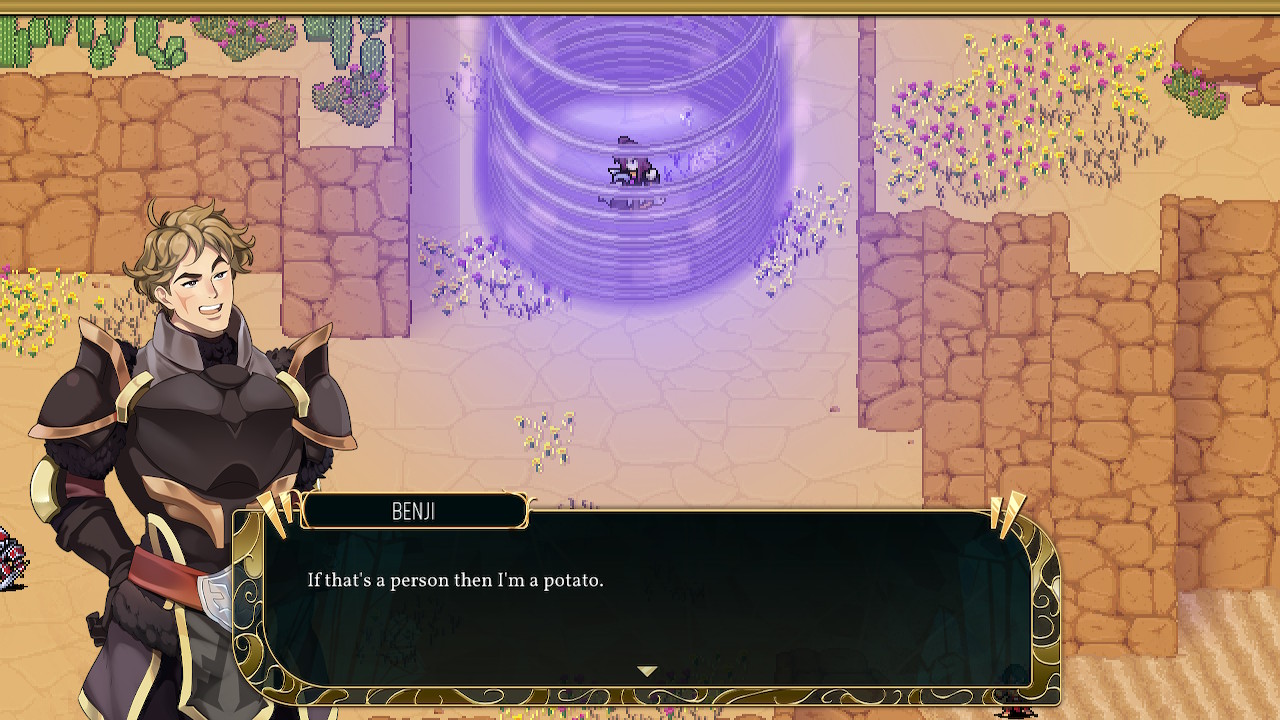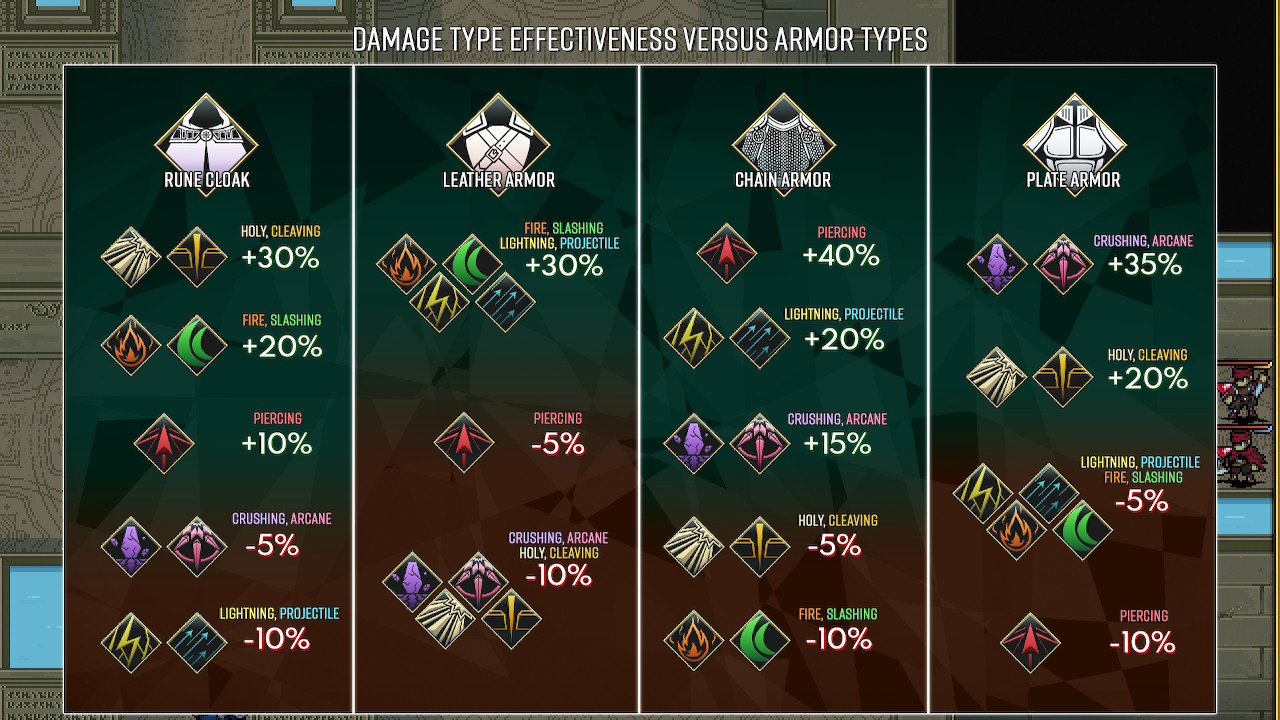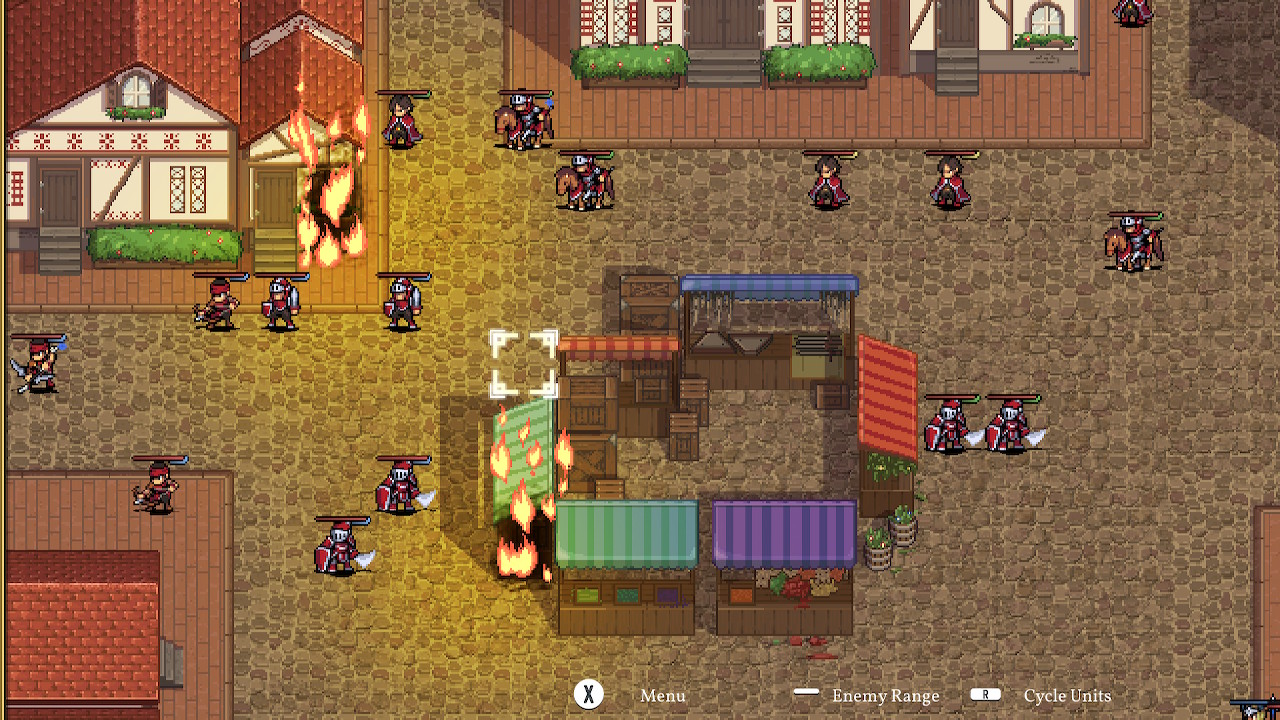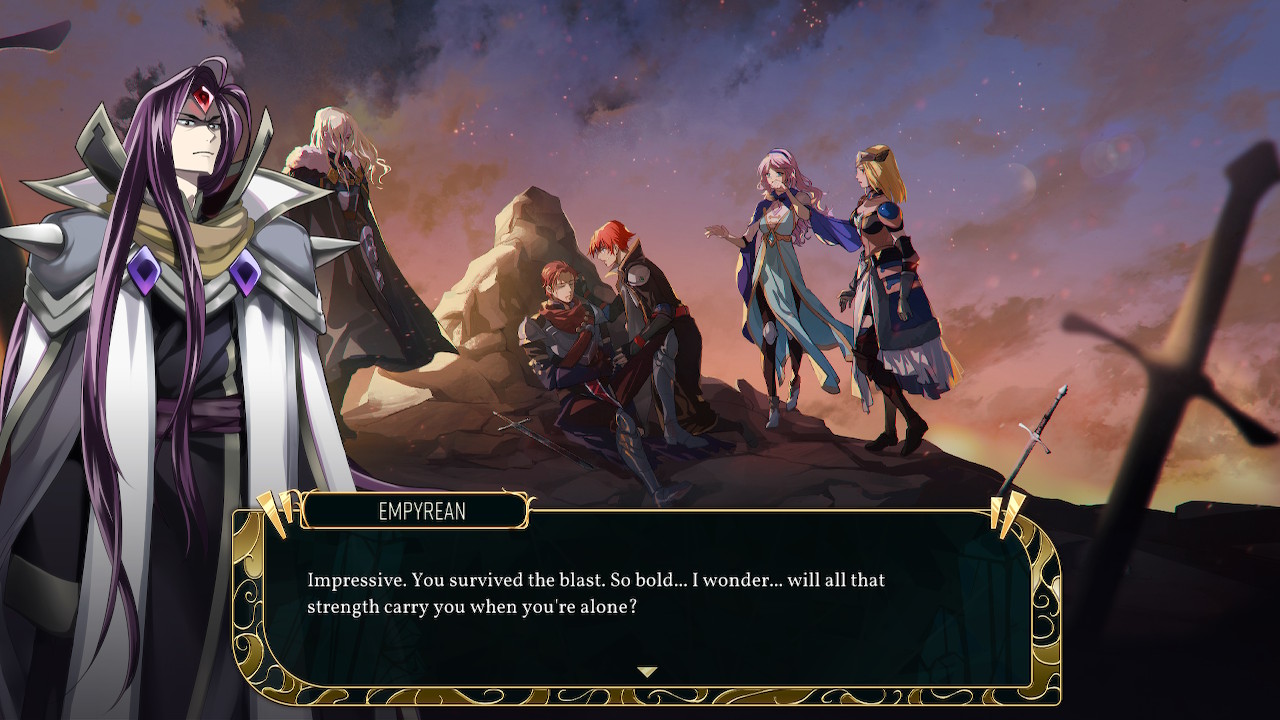There’s a thin line between paying homage to a classic game and cloning it to milk its success. A game can borrow ideas from a predecessor, but it needs its own spin on those ideas to stand out from the pack and earn the reverence of fans. Dark Deity treads this line carefully and lands on the side of creativity by the skin of its teeth. It’s an understatement to say Dark Deity borrows from Fire Emblem, but it innovates on that classic series’s formula just enough to establish an experience and identity of its own. The result is a solid, but not superb, SRPG that Switch owners hungry for turn-based tactical goodness should take a hard look at.
Dark Deity’s plot may hit close to home for anyone who’s ever feared getting drafted to war. It opens with your country’s king launching an ill-prepared military strike against another nation. In need of troops (really, meat shields), he conscripts the students of a renowned military academy, even those years away from graduation. The group of student-soldiers get dragged into war and, ultimately, a conflict among mysterious figures hunting magical artifacts known as Eternal Aspects.
This story unfolds predictably, and it quickly becomes more convoluted than it ought to be. Its saving graces — and what may keep you from ignoring it entirely — are the cast’s ever-evolving relationships with each other. Each of the 28 chapters centers on a battle that opens and closes with several minutes of characters debating recent events, getting to know each other, or working to advance their goals. You watch them develop in reaction to story beats, and their dynamic evolutions include romance, quarreling, and intrigue that keep things spicy. You can delve deeper into their relationships by witnessing hundreds of “bond” conversations at your pre-battle base camp, though exploring these and raising your bond levels offers no advantages in battle.

Most of the cast is multifaceted and relatable, and I found some of them as easy to invest in as Fire Emblem: Three Houses’s crew. Getting to know their backstories and motivations was some of the most fun I had with Dark Deity. Thirty playable characters is a little overwhelming — in-game synopses for everyone would make a sprawling cast like this easier to manage — and several felt painfully tropey, but their central role in the story pushed me to forgive the game’s fine, but not fantastic, writing.
In the unlikely event that Dark Deity‘s narrative doesn’t remind you of Fire Emblem, its combat and progression mechanics will. Battles proceed in turn-based fashion on retro-flavored, grid-based maps. You view the field and issue orders from a top-down perspective, and you zoom in on your units to enjoy a charmingly pixelated scene when they exchange blows with enemies. Chapters task you with specific objectives, but nearly all boil down to clearing the field of foes or reaching a heavily guarded tile. I would’ve welcomed more creative victory conditions, but Dark Deity’s are always clear and make sense in the context of the story.
Understanding the game’s spin on the classic weapons triangle is key to succeeding in battle. Everyone comes pre-baked with unchangeable armor and attack damage types. Depending on the type effectiveness of a unit’s brand of offense against a foe’s armor, their attack will deal extra or less damage. There are four armor and nine damage types, so remembering matchups is a pain. Thankfully, Dark Deity cleverly uses color-coded arrows to tell you whether an attack will yield additional or reduced damage. These arrows made many of my battle decisions for me, but they kept my team afloat during plenty of enemy encounters, which are tough on all but the most relaxed difficulty setting.

In one of its few other departures from Fire Emblem, each unit has four weapons on hand, and you can switch between weapons in combat without penalty. Each boasts a different power, accuracy, and critical hit chance, and you can exchange tokens you obtain on the field or from merchants to upgrade weapons up to seven times. Different weapons emphasize certain stats over others and empower you to specialize each character’s fighting style. You’re free to gamble by maximizing a dagger’s critical hit chance at the cost of its base damage, for example, or to opt for a consistent output by focusing on accuracy at the expense of other metrics.
Dark Deity poorly explains its complicated weapons system, but fans of in-depth character customization will dig it for the freedom it offers. Completing chapters also earns you Eternal Aspects your units can equip — one of the game’s more notable innovations. Each one alters a stat or two, provides a passive buff, or enhances particular abilities. Aspects never felt game-changing, but they helped balance character weaknesses and gave me more control over my team’s performance.
Speaking of customization, you begin Dark Deity with access to six archetypal classes, each of which unlocks promotions to four advanced classes at level 10 and four more at 30. You ultimately gain access to 54 classes representing the full spectrum of standard fantasy fare, ranging from Dragoons, Knights, and Battlemages to Pyromancers, Thieves, and Clerics. Each class bears distinct stats, movement and attack ranges, and damage and armor types. Each of the six starter classes has one active ability they can unleash in battle, while advanced classes retain the active ability of their base class and learn two passive skills. Each party member comes to you as a starter class, but you have complete control over their promotions.
The impressive breadth of classes encourages you to tinker with different strategies and playstyles. But the disappointingly limited selection of active abilities means that unless you’ve got an eye on your selected unit’s description window, you may struggle to distinguish it from the five other variants of Cleric or six different types of Warrior at your disposal. Each class boasts a unique 16-bit aesthetic on the field, but many are tough to tell apart. Balance issues also plague the classes. Unmounted melee fighters struggle to keep up by the mid-game, and some classes’ bizarre stat distributions render them nearly useless (I’m looking at you, Battlemage).

Balance issues aside, guiding my forces through encounter after challenging encounter stayed fresh for most of my 20-hour playthrough. The experience felt suspiciously reminiscent of Three Houses, but I repeatedly caught myself saying “just one more turn” all the same. It helped that maps here are more diverse than Three Houses’s and include an abundance of items and traps that keep you on your toes. This SRPG also ditches Fire Emblem’s punishing permadeath system, so I felt free to experiment and take risks.
The routine began to feel monotonous shortly into the narrative’s second half, though. I remained interested in the crew through to the end, but I found myself yearning for a gameplay loop that consisted of more than strikingly similar battle scenarios permeated by bits of cliché fantasy melodrama. An explorable overworld, sidequests, and other RPG hallmarks would’ve been welcome additions to diversify the game’s pace, but all are absent.
Dark Deity’s visuals may not appeal to everyone, but they helped me remain engaged with this world after the story and battles started to dull. Units appear as vibrant, 2D pixels on the field, and their 16-bit attack animations hearken back to the SNES era. The pixel art isn’t the most detailed, but it exudes character and is guaranteed to tug at the heartstrings of anyone who appreciates this retro aesthetic. Story scenes unfold through gorgeous, hand-drawn visual novel stills that invigorate the drama and make up for the absence of high-fidelity cutscenes.
This modest graphical style shouldn’t demand much of my Switch, so I was surprised to lose nearly a minute to loading screens between battle and story scenes. A few times on the battlefield, I also couldn’t select some of my units until I restarted the game — a headache that cost me some progress since you can’t save during combat. However, my framerate always held steady, and I never encountered crashes or graphical hiccups.

Though Dark Deity’s soundtrack won’t break any records, it offers a collection of lighthearted, high-fantasy tracks fitting its vibe to a T. I wouldn’t call the soundtrack memorable, but a few especially moody beats give battles an air of mystery that enhances their tension. Disappointingly, actors only voice snippets of key story and battle scenes, and the game presents all other dialogue through text boxes that do little to establish the cast’s personalities. Still, strong voice acting accompanying important scenes conveys characters’ emotions effectively and sets the tone Sword & Axe aimed for.
Dark Deity is a title that doesn’t take many chances, but its few gambles pay off. Its handful of innovations to the Fire Emblem formula produce a challenging, character-driven adventure that may yet develop a following of its own. While a lack of polish, forgettable story, and limited gameplay loop hold Dark Deity back from acclaim, an endearing cast and deep combat and customization systems render it a force to be reckoned with among the Switch’s crowded market of SRPGs.


